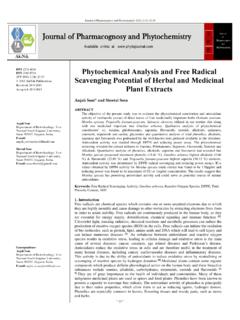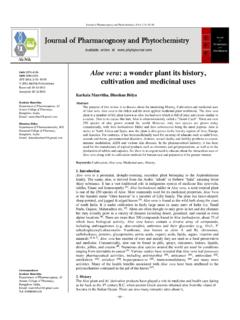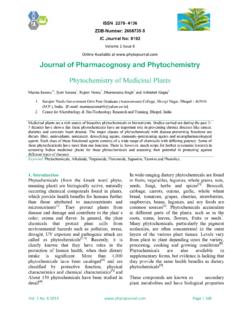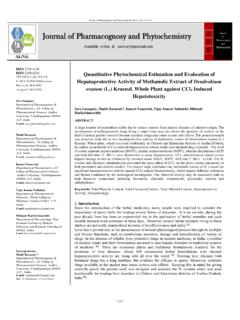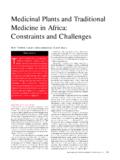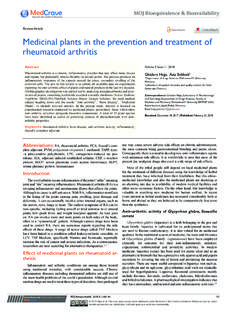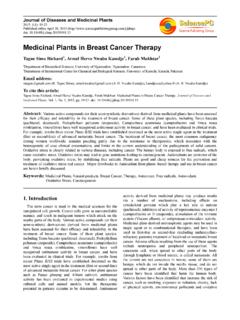Transcription of A review on medicinal plants with antidiabetic activity
1 ~ 149 ~ Journal of Pharmacognosy and Phytochemistry 2014; 3(4): 149-159 E-ISSN: 2278-4136 P-ISSN: 2349-8196 JPP 2014; 3(4): 149-159 Received: 24-09-2014 Accepted: 03-10-2014 ANM Mamun-or-Rashid PhD Research student, Graduate School of Life and Medical Sciences, Doshisha University, Japan. Md. Shamim Hossain Department of Biotechnology and Genetic Engineering, Faculty of Applied Science and Technology, Islamic University, Kushtia-7003, Bangladesh. Naim Hassan Department of Biotechnology and Genetic Engineering, Faculty of Applied Science and Technology, Islamic University, Kushtia-7003, Bangladesh.
2 Biplab Kumar Dash Lecturer, Department of Genetic Engineering and Biotechnology, Jessore University of Science and Technology, Bangladesh. Md. Ashrafuzzaman Sapon PhD Research student, Bioscience Division, Graduate school of Science & Technology, Shizuoka University, Shizuoka, Japan. Monokesh Kumer Sen Department of Biotechnology and Genetic Engineering, Faculty of Applied Science and Technology, Islamic University, Kushtia-7003, Bangladesh. Correspondence: Md. Shamim Hossain Department of Biotechnology and Genetic Engineering, Faculty of Applied Science and Technology, Islamic University, Kushtia-7003, Bangladesh.
3 A review on medicinal plants with antidiabetic activity ANM Mamun-or-Rashid, Md. Shamim Hossain, Naim Hassan, Biplab Kumar Dash, Md. Ashrafuzzaman Sapon, Monokesh Kumer Sen Abstract In the last few years, there has been an exponential growth in the field of herbal medicine and gaining popularity both in developing and developed countries because of their natural origin and less side effects. A comprehensive review was conducted to pile up information about medicinal plants used for the treatment of diabetes mellitus.
4 It is a metabolic disorder of the endocrine system and affecting nearly 10% of the population all over the world also the number of those affected is increasing day by day. The profiles presented include information about the scientific and family name, plant parts and test model used, the degree of hypoglycemic activity , and the active chemical agents. The large number of plants described in this review (108 plant species belonging to 56 families) clearly demonstrated the importance of herbal plants in the treatment of diabetes.
5 The effects of these plants may delay the development of diabetic complications and correct the metabolic abnormalities. This work stimulates the researchers for further research on the potential use of medicinal plants having antidiabetic potential. Keywords: Comprehensive review , medicinal plant, antidiabetic potential. 1. Introduction medicinal plants continue to be an important therapeutic aid for alleviating ailments of humankind. Over the last 2500 years, there have been very strong traditional systems of medicine such as Chinese, Ayurvedic, and the Unani, born and practiced, more in the eastern continent.
6 These traditions are still flourishing, since; approximately 80% of the people in the developing countries rely on these systems of medicine for their primary health care needs [1]. These plants contain substances that can be used for therapeutic purposes, of which are precursors for the synthesis of drugs [2]. A lot of research work has been carried out on some medicinal herbs and they have been found to have definite action on the nervous, circulatory, respiratory, digestive and urinary systems; as well as the sexual organs, the skin, vision, hearing and taste [3].
7 Diabetes mellitus is a group of metabolic alterations characterized by hyperglycemia resulting from defects in insulin secretion, action or both. It is made up of two types: Type I and Type II. Type I diabetes often referred to as juvenile diabetes, is insulin dependent and known to affect only 5% of the diabetic population. The Type II, which is non-insulin dependent, usually develops in adults over the age of 40. It has already been established that chronic hyperglycemia of diabetes is associated with long term damage, dysfunction and eventually the failure of organs, especially the eyes, kidneys, nerves, heart and blood vessels [4].
8 It has an adverse effect on carbohydrate, lipid and protein metabolism resulting in chronic hyperglycemia and abnormality of lipid profile. These lead to series of secondary complications including polyurea, polyphasia, ketosis, retinopathy as well as cardiovascular disorder [5]. In spite of the introduction and extensive utilization of hypoglycemic agents, diabetes and the related complications continue to be a major health problem worldwide, which is affecting nearly 10% of the population all over the world [6] and considered as a major cause of high economic loss which can in turn impede the development of nations [7].
9 It is projected to become one of the world s main disablers and killers within the next 25 years. Many factors contribute to the on-set of diabetes and these are termed as predisposing or risk factors. Environmental factors such as diet, obesity and sedentary life style increase the risk of diabetes. Other important risk factors include high family aggregation, insulin resistance, nutritional status, age and lifestyle change due to urbanization [8]. The management of diabetes is a global problem until now and successful treatment is not yet discovered [9].
10 ~ 150 ~ Journal of Pharmacognosy and Phytochemistry Currently available therapy for diabetes includes insulin and various oral hypoglycemic agents such as sulfonylureas, metformin, glucosidase inhibitors, troglitazone, etc. But these are reported to produce serious adverse side effects such as liver problems, lactic acidosis and diarrhea [10]. It is currently affecting around 143 million people [11] and the number of those affected is increasing day by day, by 2030 it is predicted to reach 366 million population worldwide [12].

